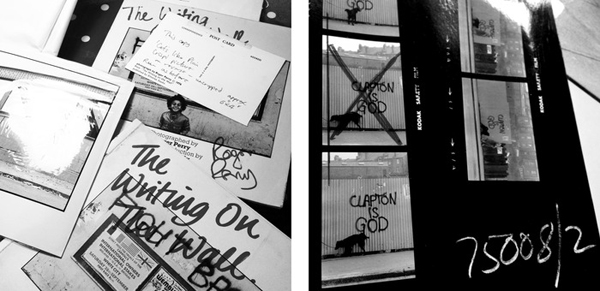https://www.kickstarter.com/projects/1281254871/the-writing-on-the-wall
The original book of London graffiti. Out of print since 1976, now reissued and expanded, with new text and unseen photographs.
After 38 years out of print, Roger Perry’s unique survey of London graffiti of the mid ’70s is finally going to be available once more. Just as relevant nearly forty years on, Perry’s book is as much a cultural history of London at the time as it is a graffiti book. Before the ‘wildstyles’ of New York came over to this fair isle, graffiti was the reserve of poets, comedians and counterculturalists. The graffiti in this book has more in common with Blake than Basquiat. Through Perry’s lens, we are offered a glimpse of a Notting Hill that gave rise to the counterculture movements and underground press of the ’70s.
The high prices commanded for original copies of the book, coupled with the opportunity to really do the photos justice through the use of modern printing technologies, were the main drive for getting this project launched.
The Writing On The Wall is a book of London graffiti, last published in 1976. The main body of the book is made up of Roger Perry’s black and white photographs of ’70s London. It’s a unique glimpse of a multicultural London, with narratives told through poetic statements daubed on squatted houses and corrugated iron fences. These statements would be forever lost to decay and demolition if it weren’t for Perry’s obsessive documentation of them.
The book was originally published just as graffiti books were beginning to be in vogue. Norman Mailer and Jon Naar’s The Faith of Graffiti had just come out, covering the scene in New York at the time. The Writing On The Wall, though, was the first one really dedicated to London graffiti. The majority of the graffiti here could be described as ‘Pre-Renaissance’ in many ways. No one would be describing this stuff as ‘art’ until Martha Cooper and Henry Chalfant’s Subway Art made it across to these shores in 1984. This work was mostly anonymous, and to paraphrase Marshall McLughan, the medium was the message. It wasn’t important how it had been written, it was simply the fact that one person felt it important enough that it should be painted on a wall for all and sundry to see.
What’s inside?
George Melly, the legendary jazz singer and art historian, wrote a wonderful introduction for the book’s initial release. This will be included in the new edition.
A new piece has also been written especially for this edition by artist and writer Bill Drummond.
The 108 photos from the original book have all been digitally transferred from Perry’s original prints, along with over 30 never before released images.
As well as Melly’s introduction, an extensive new foreword has been written by George Stewart-Lockhart, an art historian and publisher, that aims to give the images better context and understanding. Stewart-Lockhart has spent months researching the original book, working out and tracking down the original graffiti writers. The various culprits turned out to be an unlikely mix, including Situationists, poets, musicians, journalists, comedians and even members of the IRA and the Angry Mob.The new foreword includes interviews and insights from the likes of Heathcote Williams, Tony Allen, Neil Lyndon, Dave Wise, Lee Thompson, and many more.
To finish the whole book off is a biography of Perry himself, with contributions and insights from, amongst others, Time Out founder Tony Elliott, Guardian writer Ian Jack, Royal Designer for Industry Pearce Marchbank and Perry’s widow, Kate Bindloss.

Who is Roger Perry?
Roger Perry (1944-1991) was a photographer, based in London for the majority of his career. He studied at Harrow School of Art and in the late 1960’s joined a fledgeling Time Out magazine, becoming the publication’s key photographer, responsible for a number of iconic covers, as well as his work on both music and fringe theatre photography.
The Writing On The Wall was initially published in 1976 before Roger moved on to work for The Sunday Times and The Observer colour magazines where he was instrumental in his documentation of the early punk movement. A number of his portraits are now in the permanent collection of the National Portrait Gallery.
After developing severe rheumatoid arthritis, he soon became unable to take photographs. In the mid 1980s he moved to Suffolk and put his energy into restoring classic Lancias, which he did up until his early death in 1991.
Press
‘Every f**ker and his granny thinks that street art is about stencils by some bloke called Banksy but I’ve seen the past and it’s about the writing on the wall, literally. The first piece of graffiti that ever got me going was the classic ‘If it were a lady it would get its bottom pinched’ Fiat 127 billboard which someone had tagged in big black spray ‘if this lady was a car she’d run you down’… f**king genius, they don’t make them like that anymore! Her words (it had to be a woman who called that) summed up all that was great about the English: political, funny, satirical, and resistant. And it’s the same four words that I would use to describe THE WRITING ON THE WALL BY ROGER PERRY, which is a unique distillation of a London that no-longer exists, either physically, politically, or mentally. It’s a lekker book about street poetry written large in a scrawly hand on walls that probably crumbled a long time ago, but the messages, the humour, and the rhetoric still lives on. If you’re into street art then you gotta come correct otherwise you’re just fessing…’
– King ADZ (Street Knowledge, The Urban Cookbook, etc.)


